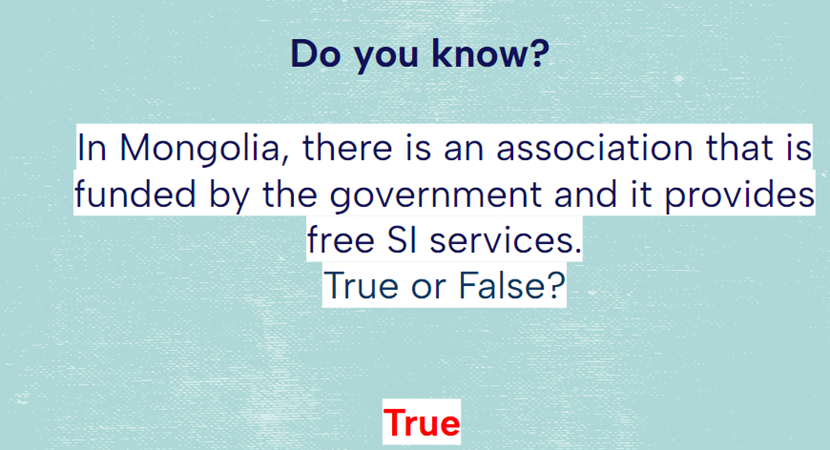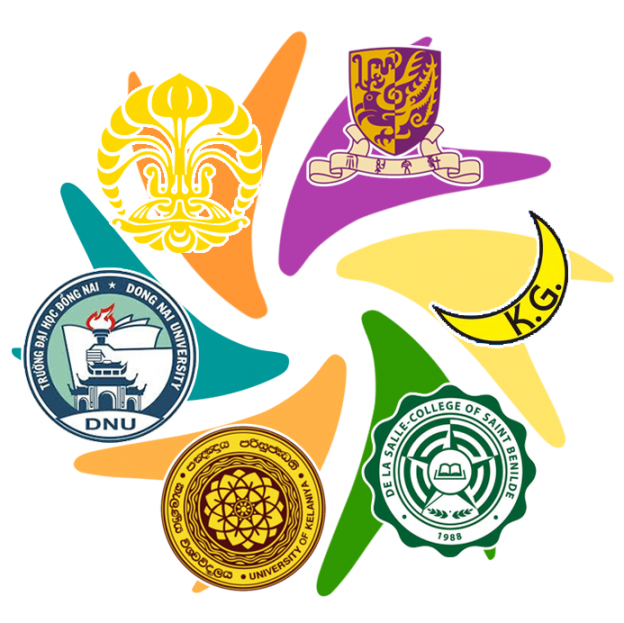Home › Forums › Webinars 2022-23 › Provision of Sign Language Interpretation in Asia › Answer to questions (in written English)
- This topic has 5 replies, 1 voice, and was last updated 1 year ago by
admin.
-
AuthorPosts
-
-
2024-03-25 at 17:38 #2229
admin
KeymasterBelow are the answers to questions in written English
-
2024-03-26 at 14:59 #2254
admin
Keymaster1. Would like to ask about the nationally certified and prefectural district certified interpreters in Japan. What is the difference between the two certifications?
Two types of sign language interpreters in Japan
SLIs of National certification (NC)
SLIs of Prefectural district certification (PDC)Numbers
NC: 4,075 (2023)
PDC: 5,229 (2019)
(Notes: Most of NCs are PDCs, because they first become PDCs.)Eligibility for taking the exam
NC: Only the age (older than 20 years old)
PDC: Completion of the national curriculum[1] (113 hrs.)Exam
NC: Written test (relevant knowledge) and practical test (Spoken Japanese to JSL and JSL to Spoken Japanese)
PDC: Written test (relevant knowledge) and practical test (Spoken Japanese to JSL and JSL to Spoken Japanese)Exam pass rates
NC: 14.2% (1999-2023)
PDC: 10-20%
(Notes: Cf. lawyer: 20-40%; certified public accountant: 10%)Jobs
NC: Government (national, local); center for people with hearing impairment; SI service provider; political opinion broadcast[2]; legal interpretation;
PDC: Government (national, local); community interpretation (part-time; registered at a local government)
(Notes: It is rare for both NCs and PDCs to work as full-time SLIs. NCs are usually allowed to get registered as PDCs without additional exams. More and more governments allow PDCs from other places.)
[1] Usually, people at the age of over 18 are allowed to join the course of the curriculum, and the course lasts 4 or 5 years.
[2] It is a special program (TV and radio) for every candidate for an election (national/local) to talk about his/her political opinion to the public before the election. It is legally guaranteed.
-
2024-03-26 at 15:02 #2255
admin
Keymaster2. It appears that certain countries and cities lack legislation regarding sign interpretation provision in medical or legal settings. As a result, interpreters with informal training will have to handle these aforementioned settings. What are the key challenges faced by sign language interpreters in medical and legal settings, and how can these challenges be overcome to ensure accurate communication with deaf patients/defendants?
Sign language interpreters who work in medical and legal settings face unique challenges due to the specialized nature of these environments. The best way to improve the accuracy of interpretation is certainly to establish a well-researched and well-implemented accreditation system.
Challenges in Medical Settings
Complex Terminology: Medical terminology can be highly technical and complex. Interpreters may struggle to convey precise meanings, which can be critical in healthcare.
Solution: Interpreters need specialized training in medical terminology and familiarity with common medical procedures. Collaboration with healthcare professionals to create a glossary of key terms can be helpful.
Patient Privacy: Medical situations often involve sensitive and private information. Maintaining patient confidentiality is crucial. Interpreters need to be trained to uphold it and there should be an accreditation system to penalize interpreters for breaches of confidentiality.
Emotional and Stressful Situations: Medical settings can be emotionally charged and stressful, particularly in emergencies or delivering difficult news.
Solution: Interpreters require training to effectively manage emotional situations and stress. Additionally, they should be informed about available resources for their emotional support, such as professional counseling organizations. Encouraging them to seek support within the interpreter community, while ensuring the strict confidentiality of their clients, is also beneficial.
Challenges in Legal Settings:
Legal Jargon: Legal proceedings involve extensive legal terminology and complex language that interpreters must accurately convey.
Solution: Interpreters in legal settings should receive training in legal terminology and procedures. Access to legal dictionaries and resources can aid in understanding the language.
Solution: Encourage the use of other forms of communication according to the deaf clients’ needs to improve the accuracy of interpretation. This is because not all deaf clients are fluent in signing, some of them have higher proficiency in reading, and they may be better supported with real-time speech-to-text devices/services.
Impartiality: In legal settings, interpreters must remain impartial and not show bias, even in challenging situations.
Solution: Interpreters need specific training on legal ethics and the importance of neutrality. Legal professionals can also provide guidance on maintaining impartiality.
Common Solutions for Both Settings:
Certification and Training: Interpreters should undergo formal training programs and obtain relevant certifications. These programs provide the necessary knowledge and skills for their respective fields.
Continual Professional Development: Ongoing training and professional development are crucial to staying updated on changes in terminology, ethics, and best practices in both medical and legal contexts.
Collaboration: Interpreters should collaborate closely with deaf individuals to understand their preferences and communication needs. They should also collaborate with the hearing experts such as doctors and lawyers to learn how to work effectively together as a team.
Cultural Competence: Understanding the cultural nuances and specific needs of deaf individuals is essential for effective communication.
Use of Technology: Utilize technology, such as video relay services, to facilitate communication in situations where in-person interpreters may not be available.
Advocacy: Work with relevant organizations and authorities to advocate for legislation and guidelines that mandate the use of qualified interpreters in all critical settings, including medical and legal.
-
2024-03-26 at 15:03 #2256
admin
Keymaster3. Hong Kong has yet to legislate Hong Kong Sign Language as one of the official languages of the region. This lack of recognition definitely impacts the establishment of sign language interpretation services and the public’s understanding of it. In my opinion, establishing a thorough system of sign language interpretation training and provision would be easier if the government is willing to acknowledge HKSL, so what challenges is Hong Kong facing in terms of recognizing HKSL?
Here are some of the challenges that Hong Kong is facing in terms of recognizing HKSL:
Attitudes of Hong Kong citizens: Gan (2019) conducted a pilot study investigating the attitudes of Hong Kong citizens towards the official recognition of HKSL. The study found that while most respondents agreed that HKSL should be recognized as an official language, there were concerns about the practicality of implementing it.
Knowledge of deaf people: Another factor that affects the recognition of HKSL is the knowledge of deaf people. The same study cited above found that deaf interviewees supported the recognition of HKSL as an official language, but they also expressed concerns about the lack of understanding of sign language among the general public.
Reference
Gan, L. E. (2019). Attitudes Towards the Official Recognition of Hong Kong Sign Language by Hong Kong Citizens. Retrieved October 28, 2023, from https://www.researchgate.net/publication/331791558_Attitudes_Towards_the_Official_Recognition_of_Hong_Kong_Sign_Language_by_Hong_Kong_Citizens
-
2024-03-26 at 15:05 #2257
admin
Keymaster4. What steps can we take to raise awareness about the importance of including deaf interpreters and advocate for their presence in various settings?
Here are some steps we can take to achieve this goal:
Education and Training: Offer workshops, seminars, and training sessions to educate organizations, professionals, and the general public about the role and significance of deaf interpreters.
Collaboration: Partner with organizations, deaf advocacy groups, and interpreters’ associations to collectively advocate for the inclusion of deaf interpreters in various settings.
Public Awareness Campaigns: Create awareness campaigns through social media, blogs, articles, and public events that highlight the contributions and expertise of deaf interpreters.
Testimonials and Success Stories: Share real-life success stories and testimonials from deaf individuals who have benefited from the support of deaf interpreters in diverse settings.
Policy Advocacy: Engage in advocacy efforts to influence policies and regulations that promote the use of deaf interpreters.
Professional Development: Encourage the professional development and certification of deaf interpreters, which can lend credibility and expertise to their work.
Collaborate with Interpreting Agencies: Work with interpreting agencies to promote the use of both hearing and deaf interpreters, as needed, and ensure that clients are aware of their options.
Community Engagement: Engage with the deaf community to understand their needs and preferences and involve them in awareness campaigns and advocacy efforts.
Cultural Competence: Promote cultural competence and sensitivity in interpreting services by highlighting how deaf interpreters can bridge cultural and linguistic gaps.
Demonstrate Benefits: Showcase the added value that deaf interpreters bring to the table, including their ability to convey nuances and cultural insights that hearing interpreters may not capture.
Legislation and Inclusion: Advocate for legislation that mandates the inclusion of deaf interpreters in specific situations where their expertise is crucial.
Research and Data: Support and conduct research on the effectiveness of deaf interpreters in various settings and use this data to bolster our advocacy efforts.
Collaborate with Allies: Seek support from allies, such as disability rights organizations, civil rights groups, and other advocates for equitable access.
Regular Awareness Events: Organize regular events, workshops, or conferences focused on the importance of deaf interpreters to keep the issue in the public eye.
-
2024-03-26 at 15:06 #2258
admin
Keymaster5. Where do you get the research information? Mongolian Government do not support the any sign language interpretation service.
Our discussions are based on published studies, online information, questionnaire findings as well as individual interviews.
We did not state that there is no support from the Mongolian Government regarding SI services. Instead, we mentioned that there is an association funded by the government, which provides free SI services. Please find the relevant slide we used below for your reference.

-
-
AuthorPosts
- You must be logged in to reply to this topic.
